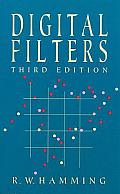
| 编号 | SH064 |
|---|---|
| 书名 | Digital Filters |
| 作者 | R. W. Hamming |
| 出版社 | PUBNET,Ingram,JA Majors |
| 出版时间 | 1998年 |
| 类别 | 教学参考 |
| 状态 | 正常 |
| 简介 | Introductory text examines the role of digital filtering in many applications, particularly computers. Focuses on linear signal processing, some consideration of roundoff effects and Kalman filters. Only calculus and some statistics required. Examples, exercises. Table of Contents Preface to the third edition 1. Introduction 1.1 What is a digital filter? 1.2 Why should we care about digital filters? 1.3 How shall we treat the subject? 1.4 General-purpose versus special-purpose computers 1.5 Assumed statistical background 1.6 The distribution of a statistic 1.7 Noise amplification in a filter 1.8 Geometric progressions 2. The frequency approach 2.1 Introduction 2.2 Aliasing 2.3 The idea of an eigenfunction 2.4 Invariance under translation 2.5 Linear systems 2.6 The eigenfunctions of equally spaced sampling 2.7 Summary 3. Some classical applications 3.1 Introduction 3.2 Least-squares fitting of polynomials 3.3 Least-squares quadratics and quartics 3.4 Modified least squares 3.5 Differences and derivatives 3.6 More on smoothing: decibles 3.7 Missing data and interpolation 3.8 A class of nonrecursive smoothing filters 3.9 An example of how a filter works 3.10 Integration: recursive filters 3.11 Summary 4. Fourier series: continuous case 4.1 Need for the theory 4.2 Orthogonality 4.3 Formal expansions 4.4 Odd and even functions 4.5 Fourier series and least squares 4.6 Class of functions and rate of convergence 4.7 Convergence at a point of continuity 4.8 Convergence at a point of discontinuity 4.9 The complex Fourier series 4.10 The phase form of a Fourier series 5. Windows 5.1 Introduction 5.2 Generating new Fourier series: the convolution theorems 5.3 The Gibbs phenomenon 5.4 Lanczos smoothing: The sigma factors 5.5 The Gibbs phenomenon again 5.6 Modified Fourier series 5.7 The von Hann window: the raised cosine window 5.8 Hamming window: raised cosine with a platform 5.9 Review of windows 6. Design of nonrecursive filters 6.1 Introduction 6.2 A low-pass filter design 6.3 Continuous design methods: a review 6.4 A differentiation filter 6.5 Testing the differentiating filter on data 6.6 New filters from old ones: sharpening a filter 6.7 Bandpass differentiators 6.8 Midpoint formulas 7. Smooth nonrecursive filters 7.1 Objections to ripples in a transfer function 7.2 Smooth filters 7.3 Transforming to the Fourier series 7.4 Polynomial Processing in general 7.5 The design of a smooth filter 7.6 Smooth bandpass filters 8. The Fourier integral and the sampling theorem 8.1 Introduction 8.2 Summary of results 8.3 The Sampling theorem 8.4 The Fourier integral 8.5 Some transform pairs 8.6 Band-limited functions and the Sampling theorem 8.7 The convolution theorem 8.8 The effect of a finite sample size 8.9 Windows 8.10 The uncertainty principle 9. Kaiser windows and optimization 9.1 Windows 9.2 Review of Gibbs Phenomenon and the Rectangular window 9.3 The Kaiser window: I subscript 0-sinh window 9.4 Derivation of the Kaiser formulas 9.5 Design of a bandpass filter 9.6 Review of Kaiser window filter design 9.7 The same differentiator again 9.8 A particular case of differentiation 9.9 Optimizing a design 9.10 A Crude method of optimizing 10. The finite Fourier series 10.1 Introduction 10.2 Orthogonality 10.3 Relationship between the discrete and continuous expansions 10.4 The fast Fourier transform 10.5 Cosine expansions 10.6 Another method of design 10.7 Padding out zeros 11. The spectrum 11.1 Review 11.2 Finite sample effects 11.3 Aliasing 11.4 Computing the spectrum 11.5 Nonharmonic frequencies 11.6 Removal of the mean 11.7 The phase spectrum 11.8 Summary 12. Recursive filters 12.1 Why recursive filters? 12.2 Linear differential equation theory 12.3 Linear difference equations 12.4 Reduction to simpler form 12.5 Stability and the Z transformation 12.6 Butterworth Filters 12.7 A simple case of butterworth filter design 12.8 Removing the phase: two-way filters 13. Chebyshev approximation and Chebyshev filters 13.1 Introduction 13.2 Chebyshev polynomials 13.3 The Chebyshev Criterion 13.4 Chebyshev filters 13.5 Chebyshev filters, type 1 13.6 Chebyshev filters, type 2 13.7 Elliptic filters 13.8 Leveling an error curve 13.9 A Chebyshev identity 13.10 An example of the design of an integrator 13.11 Phase-free recursive filters 13.12 The transient 14. Miscellaneous 14.1 Types of Filter Design 14.2 Finite arithmetic effects 14.3 Recursive versus nonrecursive filters 14.4 Direct modeling 14.5 Decimation 14.6 Time-varying filters 14.7 References |




 出版教材
出版教材 中心藏书
中心藏书